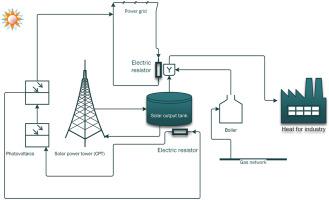100% renewable industrial decarbonization: Optimal integration of solar heat and photovoltaics
Abstract
Decarbonizing industrial high-temperature (above 500 °C) heat demand is considered as one of the most challenging areas for decarbonization of energy due to (1) their strive for high-grade heat input, and (2) CO2 emission as the by-product. Heat and electricity from solar sources (medium to high-temperature solar thermal and photovoltaics) are two potential solutions for reducing CO2 emission in the industrial heating sector. This study investigates the potential of solar energy in the form of heat and/or electricity to make a significant contribution to reduce CO2 emissions from industrial heating requirements. Analysis is performed to determine the optimal configuration of both systems along with a hybrid system in terms of both cost and emissions reductions which are compared with a natural gas-only (conventional) system. Annual hourly solar irradiation data for two locations with different climatic conditions (mild and hot climates) was generated and employed as the input to the optimization model to provide a high-resolution (hourly-based) comparison. The results showed that for the hot climate, the optimized compact parabolic trough system reduced CO2 emissions by 45% compared to the base gas-only system with an increase in 75% for cost. A 45% reduction in emissions for the location with mild weather condition resulted accompanied with an 88% increase for costs. The photovoltaic solution resulted in higher cost than that of compact parabolic trough solution in the same level of emission due to the lower conversion efficiencies of the photovoltaic cells. Beside the environmental aspects, less dependance to gas transmission network and relying on local energy sources as well as less operation/maintenance costs are the benefits of the proposed configurations.


 求助内容:
求助内容: 应助结果提醒方式:
应助结果提醒方式:


